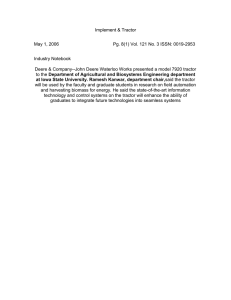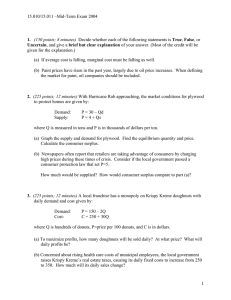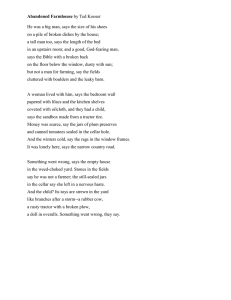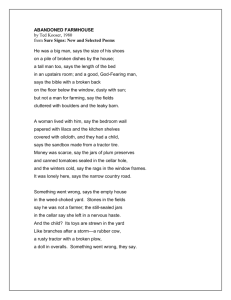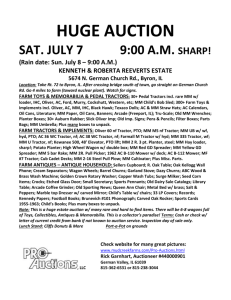Sloan School of Management 15.010/ 15.011 Massachusetts Institute of Technology
advertisement
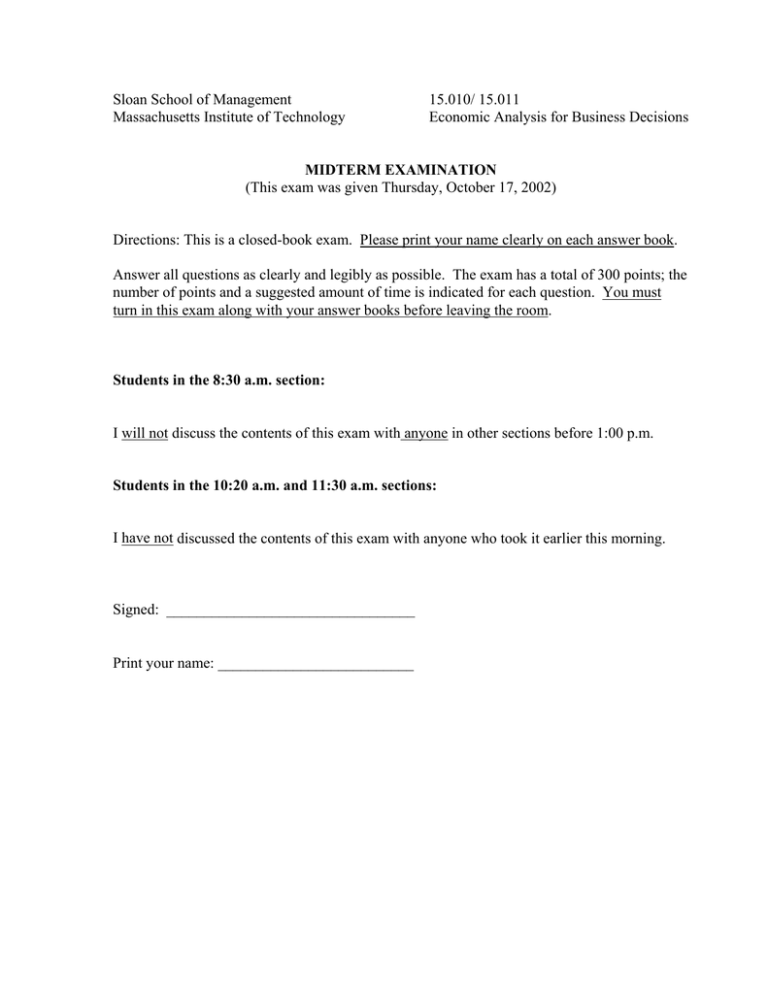
Sloan School of Management Massachusetts Institute of Technology 15.010/ 15.011 Economic Analysis for Business Decisions MIDTERM EXAMINATION (This exam was given Thursday, October 17, 2002) Directions: This is a closed-book exam. Please print your name clearly on each answer book. Answer all questions as clearly and legibly as possible. The exam has a total of 300 points; the number of points and a suggested amount of time is indicated for each question. You must turn in this exam along with your answer books before leaving the room. Students in the 8:30 a.m. section: I will not discuss the contents of this exam with anyone in other sections before 1:00 p.m. Students in the 10:20 a.m. and 11:30 a.m. sections: I have not discussed the contents of this exam with anyone who took it earlier this morning. Signed: _________________________________ Print your name: __________________________ 15.010/15.011 –Sample Mid-Term Exam (given in 2002) 1 1. (40 points; 12 minutes) Decide whether each of the following statements is True, False, or Uncertain, and give a brief but clear explanation of your answer. (Most of the credit will be given for the explanation.) 1a) People who buy CD-RW drives also buy CD-RW disks. Therefore, drives and disks are in the same market. 1b) Optimal production for a monopolist is at the point of minimum average cost. 2. (65 points; 15 minutes) Old McAdams had a farm. … And on this farm, he grows some corn. … To grow corn, he needs a tractor. A new tractor costs $100,000. There is a very liquid resale market for tractors; a tractor that is one year old sells for $70,000 and a tractor that is two years old sells for $45,000. For simplicity, assume that all tractors three or more years old cannot be used to grow corn and sell for $0. These prices are expected to stay the same in the future. The variable cost of producing corn is the same regardless of whether you are using a tractor that is new, one year old or two years old. (a) Old McAdams faces an interest rate of 10%. What is the user cost of capital associated with using a new tractor for one year? What is the user cost of capital associated with using a one year old tractor for one year? What is the user cost of capital associated with using a two year old tractor for one year? (b) Old McAdams is formulating a plan for growing corn for the next three years. What is the optimal arrangement for the necessary tractor input over the three years? (For instance, should he buy a new tractor and use it for three years, or something else?) 3. (65 points; 15 minutes) Suppose there are two companies, Tinysoft and Golden Delicious (GD), that develop a new software technology with an expected market size of 20 million units next year. Distributing the software on the Web and in computer stores, the constant marginal cost will be $10, while the price will be $65. If Tinysoft spends $100 million on a promotional campaign this period, it can capture 50% of the market next year. However, if it spends $310 million this period, it can capture 70% of the market next year. Assume the discount rate is 10%. (a) Which promotional campaign should Tinysoft pursue? (b) Now suppose that this software exhibits a network externality so that the $310 million campaign will allow Tinysoft to capture the entire market. Which promotional campaign should Tinysoft pursue now? (c) After the promotional campaign but before production, a third company introduces a software package that makes Tinysoft’s technology virtually obsolete. Instead of $65, the price that Tinysoft now commands is only $5. The CEO of TinySoft issues a statement to his workforce that concludes: “Though these are hard times, we stay committed to our product. We will not let our efforts and our promotional campaign go to waste!” As a consultant to TinySoft, comment on the CEO’s statement. 15.010/15.011 –Sample Mid-Term Exam (given in 2002) 2 4. (90 points; 26 minutes) There are two sources of demand for broccoli. The first source is human consumption, which has demand function D(p) = 10 – p (where price p is in dollars per pound and quantity is in millions of pounds). The second source is as a food source for animal production, and this source is infinitely elastic at p = 8. The supply function for broccoli is S(p) = p. (a) Draw an appropriate supply-demand diagram of the market for broccoli. What are the price and total quantity of broccoli supplied? What is consumer surplus at this point? What is producer surplus at this point? (b) The government starts a “Vegetables are good for you!” campaign and gives subsidies for broccoli consumption. In particular, the government pays $1 per pound of broccoli. Assume first that the government cannot distinguish between human and animal consumption. What is the new equilibrium price and quantity? What is the cost of the subsidy to the government? Is there any deadweight loss from this government intervention? If so, how much? (c) Assume now that the government finds a way to distinguish between animal and human consumption. The government now gives the subsidy only for human consumption. What is the new equilibrium price and quantity? Is there any deadweight loss from this government intervention? If so, how much? 5. (40 points; 12 minutes) From regression analysis applied to data, average costs of production for each firm in your industry obey ln ACt = 3.87 - .2 ln (Qt) – .3 ln (CumQt) where Qt is current annual production, and CumQt is cumulative (total) production over the last five years. Now, your firm has always had, and still has, a market share of 25%. Your main competitor has always had, and still has, a market share of 20%. What is your cost advantage over your competitor? (Show your calculation as well as stating any assumptions you may need to make.)

